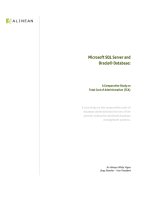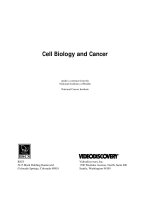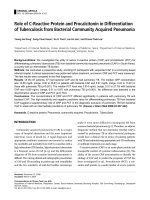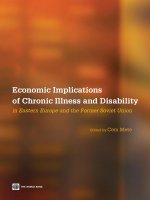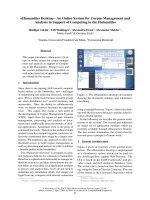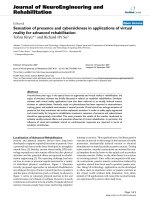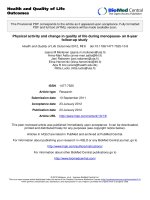Severe persistent unremitting dermatitis, chronic diarrhea and hypoalbuminemia in a child: Hartnup disease in setting of celiac disease
Bạn đang xem bản rút gọn của tài liệu. Xem và tải ngay bản đầy đủ của tài liệu tại đây (865.3 KB, 3 trang )
Ciecierega et al. BMC Pediatrics (2014) 14:311
DOI 10.1186/s12887-014-0311-6
CASE REPORT
Open Access
Severe persistent unremitting dermatitis, chronic
diarrhea and hypoalbuminemia in a child;
Hartnup disease in setting of celiac disease
Thomas Ciecierega1, Imad Dweikat2, Mohammad Awar3, Maher Shahrour3, Bassam Abu Libdeh3 and Mutaz Sultan3*
Abstract
Background: Celiac disease (CD) is a complex autoimmune disorder that can lead to an inflammatory small
intestinal villous atrophy and malabsorption.
Hartnup disease is an autosomal recessive disorder caused by increased urinary excretion of neutral amino acids.
Co-occurrence of Hartnup disease and CD is extremely rare with only a single case reported.
Case presentation: We report a 3-year girl with chronic diarrhea, Hypoalbuminemia and exfoliative erythema. She
was diagnosed with celiac disease, which did not improve on gluten free diet. Hartnup disease was suspected and
was confirmed by neutral aminoaciduria. Niacin was started and followed by dramatic improvement.
Conclusion: Presence of Celiac and Hartnup disease in single individual is very rare. Complete nutritional
assessment of refractory celiac patient can reveal underlying nutritional deficiency.
Background
Dermatoses are frequently the presentation of various
metabolic and malabsorptive syndromes with Celiac
Disease (CD) being the most common one. Celiac disease is an autoimmune, gluten-dependent enteropathy
that leads to small bowel mucosal damage causing malabsorption of ingested nutrients. Exfoliative erythema
can be found among celiac patients due to malabsorption of many microelements. While Celiac disease is a
relatively common disorder in children, Hartnup disease is not.
Co-occurrence of Hartnup disease and CD is extremely rare with only a single case reported.
Case presentation
A 3-year-old Palestinian girl was referred with primary
complains of persistent chronic diarrhea and hypoalbumenemia since one year of age. Additional symptoms included significant photosensitivity and severe scaly skin
rash involving face, neck, lower and upper extremities
(Figure 1).
* Correspondence:
3
Makassed Hospital, Alquds University, Medical College, Jerusalem, Palestine
Full list of author information is available at the end of the article
On further investigation, she also complained of painful recurring oral ulcers and very low energy level.
She was admitted for severe chronic malnutrition. Her
physical exam was significant for abnormally low growth
parameters (weight 10 kg and height 83 cm; both were
two standard deviations (2SD) below normal), generalized pitting edema and mild abdominal distension without organomegly.
Initial evaluation included labs and stool studies.
Abnormalities on initial laboratory evaluation included
anemia (Hgb 10.1 g/dl reference range (11.5-16), and coagulation abnormalities (Prothrombin Time17.4 (13-14.5),
INR 1.6, (1-1.14). Other pertinent results: alkaline phosphatase 171 U/L (100-320), ALT: 26 U/L (5-45), AST: 34
U/L (10-35), total protein: 6.2 g/dl (6-8), albumin 1.9 g/dl
(3.6-5.20). Of note, rheumatoid factor, anti-nuclear antibody, Human Immunodeficiency Virus (HIV) status, vitamin B12, folate, ferritin level and urine organic acids were
all normal.
Her Celiac screening was abnormal with tissue transglutaminase IgA antibodies (tTG) >200 U/ml (<12) and
total IgA 150 mg/dl (14-123) She underwent upper endoscopy which revealed significant duodenal blunting ad
scalloping. Biopsies were consistent with diagnosis of
CD (Marsh scale 3b). Patient was started on nasogastric
© 2014 Ciecierega et al.; licensee BioMed Central. This is an Open Access article distributed under the terms of the Creative
Commons Attribution License ( which permits unrestricted use, distribution, and
reproduction in any medium, provided the original work is properly credited. The Creative Commons Public Domain
Dedication waiver ( applies to the data made available in this article,
unless otherwise stated.
Ciecierega et al. BMC Pediatrics (2014) 14:311
Figure 1 Initial Presentation: significant photosensitivity with
severe scaly desquamating skin rash and hyperpigmentation
involving the face, neck, lower and upper extremities.
tube feeding with high-protein, gluten-free diet and supplemented with Total Parental Nutrition (TPN), intravenous (IV) zinc sulphate, microelements (Pediatrace)
and multivitamins (Infuvite Pediatric). Of note, zinc level
returned normal.
Patient had only mild clinical and laboratory improvement after 2 weeks of aggressive treatment. She required
multiple albumin infusion with only transient improvements. A short-course of parental steroids (Methylprednisolon 2 mg/kg, 10 days) for the suspicion of refractory
CD also did not improve her clinical status. Because of
combination of non-improving clinical course and persistent symptoms, she was re-evaluated and suspected to
have a niacin deficiency (The Pellagra) based on the distribution of the rash, photosensitivity, intractable chronic
diarrhea and low mood (the 4D’s: Diarrhea, Dermatitis,
Dementia and Death). The patient was started on oral niacin (50 mg three times daily) followed shortly by a dramatic improvement and subsequent complete resolution
of her symptoms within four weeks from the diagnosis
(Figure 2). Reviewing the dietary history showed that she
was consuming decent amount of protein from fish, meat
and diary products ruling out primary cause of inadequate
Page 2 of 3
Figure 2 Patient after treatment: a complete resolution of
previous symptoms.
intake of niacin. Hartnup disease was considered as a secondary cause of niacin deficiency.
Diagnosis of Hartnup disease was confirmed by presence of neutral aminoaciduria; her urine aminoacids
chromatography showed increased levels of excreted
neutral amino acids (glutamine, valine, phenylalanine,
leucine, asparagine, citrulline, isoleucine, threonine, alanine, serine, histidine, tyrosine, tryptophan). Her urine
excretion of proline, hydroxyproline and arginine was
normal which differentiates Hartnup disease from other
causes of gross aminoacidurea.
She remains on gluten free diet with daily niacin supplementation with no relapse of any of her symptoms.
Although celiac disease is considered a fairly common
disease with estimated prevalence of up to 2% in general
population (Europe and United States), hartnup disease
is an extremely rare disorder. The overall incidence of
Hartnup disease by newborn screening program is 1 case
per 25,000 births in New South Wales and 1 case per
54,00 in Quebec [1]. There is no available data on the incidence of the disease in Palestine.
CD can be associated with extra-intestinal manifestations. Among them, several skin pathologies have been
described [2-4]. Dermatitis herpetiformis is a well-
Ciecierega et al. BMC Pediatrics (2014) 14:311
described entity, presenting as an itchy, chronic, papulovesicular eruption, which may leave pigmentation and
scarring [3]. Absence of pruritus and vesicular lesions, in
addition to non resolving rash after gluten free diet
made dermatitis herpetiformis unlikely in our patient.
Exfoliative erythema of malnutrition is a term for skin
lesions caused by a combination of multiple deficiencies in
vitamins, microelements, essential fatty acids and amino
acids. On admission, the provisional diagnosis was malabsorption due to underlying Celiac disease with severe
acute malnutrition causing exfoliative erythema. Parenteral nutrition, IV zinc and multivitamin supplementation failed to improve her dermatological manifestations.
Dramatic response to niacin supplement was diagnostic
for pellagra.
Hartnup disorder is an autosomal recessive abnormality of renal and gastrointestinal neutral amino acid
transport [5,6]. The failure to resorb amino acids in this
disorder is compensated by a protein-rich diet. However,
in combination with a poor diet and other factors like
malabsorption, more severe symptoms can develop.
Hartnup disorder was first described in two siblings of
the Hartnup family in 1956. Soon after its initial description, it was suggested that Hartnup disease results from
a tissue specific failure to resorb neutral amino acids in
the kidney and intestine.
The causative gene, SLC6A19, is located on a locus on
short arm of chromosome 5 (band 5p15.33), which encodes a defective transporter [7]. The transporter is
found in kidney and intestine, where it is involved in the
reabsorption of all neutral amino acids. An abnormality
in tryptophan transport leads to niacin deficiency, which
is responsible for the pellagra-like eruptions.
In our case, the severity of the skin lesions can be explained by the coexistence of two diseases. Most likely
the combined deficiencies in amino acids and proteins
led to exacerbation of hartnup disease, which is asymptomatic in the majority of the cases.
Co-occurrence of Hartnup disease and CD is extremely rare with only a single case reported [8].
Conclusion
Presence of Celiac and Hartnup disease in single individual is very rare. It appears that CD with its severe enteropathy have uncovered the Hartnup disease and magnified
symptoms of niacin deficiency. Complete nutritional assessment of refractory celiac patient can reveal underlying
nutritional deficiency.
Page 3 of 3
the written consent is available for review by the Editor
of this journal.
The local ethics committee of makassed hospital for
publication approved the case for publication.
Abbreviation
CD: Celiac disease.
Competing interests
The authors declare that they have no competing interests.
Authors’ contributions
All authors have been involved in drafting the manuscript, revising it
critically for important intellectual content; and have given final approval of
the version to be published. Dr. MS had the main role in writing the body of
the manuscript. All authors read and approved the final manuscript.
Acknowledgement
The authors would like to thank Dr. Sarah Abu Rumeleh for her excellent
care of the patient.
Author details
1
New York Presbyterian, Weill Cornell Medical College, New York, USA.
2
An-Najah National University, P.O. BOX 7, Nablus, West Bank, Palestine.
3
Makassed Hospital, Alquds University, Medical College, Jerusalem, Palestine.
Received: 3 August 2014 Accepted: 10 December 2014
References
1. Levy H: Hartnup Disorder. In The metabolic and molecularbases of inherited
disease. Edited by Scriver CR, Beaudet AL, Sly WS, Valle D. New York:
McGraw-Hill; 2001:4957–4969.
2. Collin P, Reunala T: Recognition and management of the cutaneous
manifestations of celiac disease: a guide for dermatologists. Am J Clin
Dermatol 2003, 4:13–20.
3. Rivera E, Assiri A, Guandalini S: Celaic disease. Oral Dis 2013, 19:635–641.
4. Abenavoli L, Proietti I, Leggio L, Ferrulli A, Vonghia L, Capizzi R, Rotoli M,
Amerio PL, Gasbarrini G, Addolorato G: Cutaneous manifestations in celiac
disease. World J Gastroenterol 2006, 12:843–852.
5. Kraut JA, Sachs G: Hartnup disorder: unraveling the mystery. Trends
Pharmacol Sci 2005, 26:53–55.
6. Broer S, Cavanaugh JA, Rasko JEJ: Neutral amino acid transport in epithelial cells
and its malfunction in Hartnup disorder. Biochem Soc Trans 2005, 33:part 1.
7. Seow HF, Bröer S, Bröer A, Bailey CG, Potter SJ, Cavanaugh JA, Rasko JE:
Hartnup disorder is caused by mutations in the gene encoding the
neutral amino acid transporter SLC6A19. Nat Genet 2004, 9:1003.
8. Sander CS, Hertecant J, Abdulrazzaq YM, Berger TG: Severe exfoliative
erythema of malnutrition in a child with coexisting coeliac and
Hartnup’s disease. Clin Exp Dermatol 2008, 34:178–182.
Submit your next manuscript to BioMed Central
and take full advantage of:
• Convenient online submission
• Thorough peer review
• No space constraints or color figure charges
• Immediate publication on acceptance
Consent
• Inclusion in PubMed, CAS, Scopus and Google Scholar
Written informed consent was obtained from the patient’s father her legal guardian, for publication of this
Case report and any accompanying images. A copy of
• Research which is freely available for redistribution
Submit your manuscript at
www.biomedcentral.com/submit



